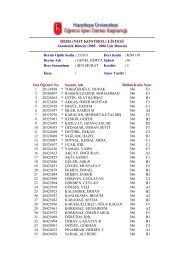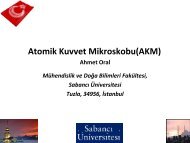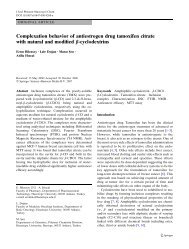2738 DUBOLAZOV ET AL.workers 12 investigated <strong>the</strong> process <strong>of</strong> complexformation between PAA and UO 2þ 2 , using potentiometryand differential pulse polarographytechniques. It was found that polyelectrolyteforms intrapolymer chelates with actinide ionsand complex formation completes with <strong>the</strong> composition<strong>of</strong> UO 2þ2(carboxylate) 2 . The resulting complexformation constants revealed that PAA hasshown much higher complex ability than that <strong>of</strong>low-molecular-weight species such as succinicand propionic acids. This phenomena wereexplained by <strong>the</strong> assumption that <strong>the</strong> concentration<strong>of</strong> ligands is higher in <strong>the</strong> domain so thatonce <strong>the</strong> metal ion is attached to one group on<strong>the</strong> polymer chain, <strong>the</strong> o<strong>the</strong>r ligands coordinatemore easily. It was also found that PAA formsmore stable complex with uranyl ion than withcopper ion. 11Many researchers have investigated <strong>the</strong> <strong>complexation</strong>behavior between polymer and metalions using ultrafiltration, ion exchange, ionselective electrode potentiometry, and severalspectroscopic techniques. Luminescence spectroscopyin general and time-resolved fluorescencespectroscopy are very sensitive techniques for<strong>the</strong> analysis, speciation, and interactions <strong>of</strong> actinideand lanthanides. 13 There are however fewpapers in <strong>the</strong> literature about <strong>the</strong> <strong>complexation</strong>behavior <strong>of</strong> functional group-containing polymerssuch as PAA with uranyl ions by using luminescencespectroscopy. 14 Both molecular structureand chemical surroundings have an influence onwhe<strong>the</strong>r a molecule can produce luminescence.These factors, including chemical structure, temperature,pH, ionic strength, solvent type, concentration,and dissolved oxygen, can affectemission intensity while luminescence occurs. 15The excitation and emission spectra <strong>of</strong> many fluorophores(fluorescent sensitive molecules) aresensitive to <strong>the</strong> polarity <strong>of</strong> <strong>the</strong>ir surroundingenvironment. As a consequence, quenching <strong>of</strong>fluorescence is observed if complex affects <strong>the</strong>electronic structure <strong>of</strong> <strong>the</strong> fluorophore. For somecations, sensing methods were established thatrely on <strong>the</strong> intrinsic optical properties. Somemetal ions show absorption (ranging from <strong>the</strong> UVto <strong>the</strong> near infrared) or luminescence. Examplesare <strong>the</strong> detection <strong>of</strong> Cu(II) 16 or <strong>the</strong> uranyl ion. 14,17Luminescence <strong>of</strong> hexavalent uranium in solutionand solid state has been known for morethan 150 years. All <strong>the</strong> electrons in <strong>the</strong> stronglybonded UO 2þ2structure are paired. Thus, <strong>the</strong>ground electronic level is a singlet. To formhigher-energy electronic states, one <strong>of</strong> <strong>the</strong> bondingelectrons is transferred to <strong>the</strong> 5f nonbondingatomic orbitals <strong>of</strong> <strong>the</strong> uranium ion. 18 Thus, <strong>the</strong>fluorescence spectrum is <strong>the</strong> result <strong>of</strong> <strong>the</strong> transitionsfrom <strong>the</strong> first excited electronic level to <strong>the</strong>ground singlet and <strong>the</strong> vibrational levels associatedwith <strong>the</strong> singlet. Using this fluorescence <strong>of</strong>uranyl, <strong>the</strong> <strong>complexation</strong> <strong>of</strong> uranyl ion with someinorganic and organic systems has beenstudied. 13,15 Application <strong>of</strong> U(VI) luminescenceto speciation <strong>of</strong> U(VI) however has forwardeddiscrepant results and interpretations. Especiallydependence <strong>of</strong> fluorescence behavior on pHis discussed in terms <strong>of</strong> mutually exclusive interpretations.Complexation studies and migration<strong>of</strong> radionuclides such as uranium are quiteimportant from environmental pollution andsafety point <strong>of</strong> view. The advantages <strong>of</strong> <strong>the</strong> use <strong>of</strong>polyelectrolytes such as PAA are easy recovery <strong>of</strong><strong>the</strong> uranyl ion from aqueous systems.In our previous study 19 <strong>the</strong> mechanism <strong>of</strong>interaction between PAA and uranyl ions inaqueous solutions and <strong>the</strong> restrictive role <strong>of</strong> Coulombicinteractions were confirmed using conductometric,potentiometric, <strong>the</strong>rmal analysis,and FT-IR spectroscopic methods. In this study,we tried to show <strong>the</strong> effect <strong>of</strong> some factors suchas pH, salt concentration, and temperature onluminescence properties <strong>of</strong> UO 2þ2ions complexedwith PAA in aqueous solutions.EXPERIMENTALPAA with weight-average molecular weight (M w )2.3 10 5 was purchased from BDH Chem. Corp.(England) and used without fur<strong>the</strong>r purification.Uranyl ion stock solutions (c ¼ 0.001 mol/L) wereprepared from hexahydrate <strong>of</strong> uranyl nitrateUO 2 (NO 3 ) 2 6H 2 O (Merck, Darmstadt, Germany).Inorganic salts (NaNO 3 and KNO 3 ) <strong>of</strong> analyticalgrade were used as received.The PAA/UO 2þ2solutions were prepared byadding PAA solution (c ¼ 0.002 mol/L on arepeating unit basis) into UO 2þ2stock solutions.In all experiments <strong>the</strong> [repeating unit <strong>of</strong> PAA]/[metal] concentration ratio was 2 (stoichiometry<strong>of</strong> PAA/UO 2þ2complex), keeping <strong>the</strong> total volumeconstant at 10 mL.To investigate <strong>the</strong> pH effect on <strong>the</strong> formation<strong>of</strong> PAA/UO 2þ2complex, a set <strong>of</strong> solutions withpH varying from 1.88 to 4.02 were prepared byusing 0.05 M nitric acid or sodium hydroxidesolutions. The pH values <strong>of</strong> <strong>the</strong> aqueous mixtureswere determined with a digital pH 211
FACTORS AFFECTING POLYACRYLIC ACID/URANYL ION COMPLEX FORMATION 2739microprocessor pH meter (Hanna Instruments,Germany).The complex solutions with different concentrations<strong>of</strong> inorganic salts were prepared by addingcorresponding alkali-metal nitrate to PAAand UO 2þ2solutions separately followed by <strong>the</strong>irmixing to make up <strong>the</strong> total solution. Temperatureeffect on <strong>the</strong> <strong>complexation</strong> <strong>of</strong> PAA withuranyl ions was studied by changing <strong>the</strong> temperature<strong>of</strong> complex solution from 25 to 50 8C.UO 2þ2emission spectra were recorded on a PerkinElmerLS 55 luminescence spectrometer (PerkinElmerInstruments, England) under excitationat 310 nm. All measurements were carriedout at ambient temperature within 10 min aftermixing <strong>of</strong> components for salt concentration andpH investigations. The deconvolution <strong>of</strong> <strong>the</strong>emission spectra was performed by resolving <strong>the</strong>peaks using a computer program (Peakfit 3.0s<strong>of</strong>tware).Turbidimetric measurements were carried outwith a Philips model 8715 UV–vis spectrophotometerat 400 nm.RESULTS AND DISCUSSIONThe luminescence properties <strong>of</strong> uranium speciesin aqueous solutions are known to be stronglyinfluenced by <strong>the</strong>ir immediate coordinative environment.20 Earlier 19 we showed <strong>the</strong> preliminaryresults <strong>of</strong> very interesting behavior <strong>of</strong> UO 2þ2emission spectra in <strong>the</strong> presence <strong>of</strong> PAA <strong>of</strong> differentconcentrations: at <strong>the</strong> concentration ratio[repeating unit <strong>of</strong> PAA]/[metal] ¼ 2, new hypertransitionshoulder at 483 nm appeared, whichis probably due to complex formation betweenUO 2þ2and PAA.The basic structure <strong>of</strong> <strong>the</strong> uranyl nitratehydrates is shown as [UO 2 (NO 3 ) 2 (H 2 O) 2 ]mH 2 O,where m ¼ 0, 1, and 4. 21 Basically, <strong>the</strong> linearuranyl ion is coordinated to two water moleculesand two bidentate nitrate ions. O<strong>the</strong>r water moleculesin <strong>the</strong> trihydrate (m ¼ 1) and hexahydrate(m ¼ 4) are linked loosely to <strong>the</strong> coordinatedwater molecules by means <strong>of</strong> hydrogen bonding.The removal <strong>of</strong> <strong>the</strong> mH 2 O does not affect <strong>the</strong> fluorescencespectrum significantly. However, it iswell known that <strong>the</strong> water molecules adjacent to<strong>the</strong> uranyl ion affect <strong>the</strong> fluorescence lifetime.Among <strong>the</strong> hydrates <strong>of</strong> uranyl nitrate <strong>the</strong> hexahydrate,which has <strong>the</strong> highest number <strong>of</strong> watermolecules in <strong>the</strong> unit cell, is expected to lead toan increase in <strong>the</strong> lifetime.Figure 1. Emission spectra <strong>of</strong> aqueous UO 2þ2at differentn ¼ PAA on a repeating unit basis /UO 2þ2values:(a) n 2 and (b) (n > 3). k ex ¼ 310 nm.The emission spectra <strong>of</strong> UO 2þ2aqueous solutionsin <strong>the</strong> absence and presence <strong>of</strong> PAA withdifferent concentrations under excitation at310 nm are shown in Figure 1. When n < 2, increasein emission intensity is strongly related toPAA concentration and emission peaks shift tolower wavelengths (Fig. 1a) due to coordination<strong>of</strong> UO 2þ2ions by PAA. This can be explained by<strong>the</strong> expulsion <strong>of</strong> some <strong>of</strong> <strong>the</strong> water moleculescoordinated to uranyl ions by complex formation.22 It is important to note that <strong>the</strong> increasein PAA concentration is accompanied by significantchanges in <strong>the</strong> spectral shape with appearance<strong>of</strong> a new shoulder at 483 nm (Fig. 1b) untilstoichiometric ratio reaches <strong>the</strong> value <strong>of</strong> n ¼ 2(PAA on a repeating unit basis/UO 2þ2¼ 2:1 Mratio). Formation <strong>of</strong> shoulders around <strong>the</strong> mainpeaks <strong>of</strong> UO 2þ2has also been observed for <strong>the</strong><strong>complexation</strong> <strong>of</strong> uranyl ions with some a-substitutedcarboxylic acids in <strong>the</strong> work <strong>of</strong> Moll et al. 23For higher n values however, (PAA on a repeatingunit basis/UO 2þ2>4) decrease in emissionintensity has been observed, which can beexplained by <strong>the</strong> quenching effect <strong>of</strong> PAA in








